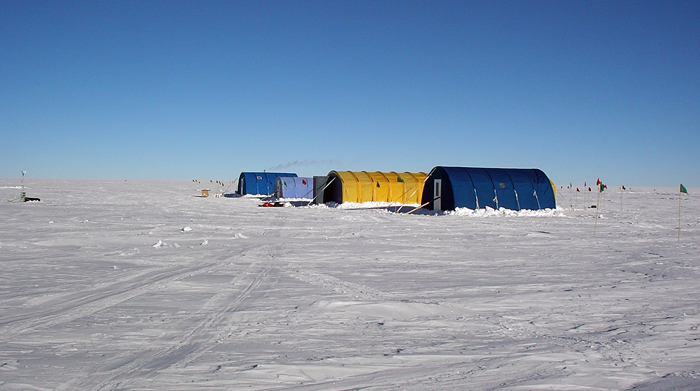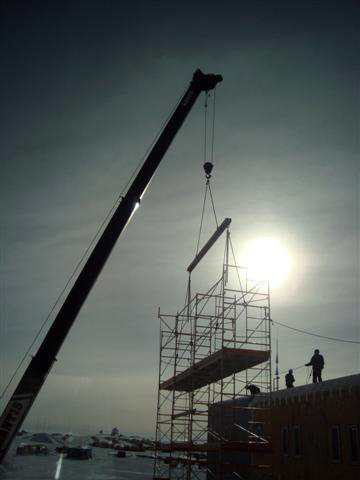|
Field of dreamsSouth Pole Station success draws more projects and work at the bottom of the worldPosted December 19, 2008
In many ways, the South Pole Station The South Pole Telescope (SPT) It’s truly been a case of “if you build it, they will come.” “The good news is that we’ve become a victim of our own success. The bad news is that we need to be prudent and figure out how we can support that success,” observed Jerry Marty, the National Science Foundation’s The comment refers to the ever-increasing workload at the station. Engineers designed the new building to house a maximum of 154 people in the summer and 50 in the winter. But the summer population continues to max out at about 260, with additional people bunking mainly in Korean War-era heated tents called Jamesways. Related Sun Stories
The population includes not just scientists but the support personnel required to run the station, which functions like a small town. In addition, construction crews are still at work on several projects to modernize the new station. IceCube is a construction site in itself, with its team of 50 people. More than a dozen NSF grantees are expected at Pole for the SPT experiment to make adjustments to the telescope. In addition to small, college dorm-style rooms, the new building boasts a hydroponic greenhouse, a dining hall with windows looking onto the geographic pole, a full-size gymnasium and science labs. “We’ve made it very comfortable to do world-class science,” noted Beth Watson, South Pole Station Support supervisor. Now the Pole has been called upon to serve as a way station for a deep-field project in East Antarctica, a high-altitude region called the Antarctic Gamburtsev Province (AGAP) There will be two fields camps for the project this year, one supported by the USAP and dubbed AGAP South. Australia and Britain are running AGAP North. At about 3,500 meters, scientists and support staff need a place en route to acclimatize to the altitude. The South Pole is at physical altitude of 2,835 meters, though pressure changes can make it feel like it’s more than 3,600 meters. The original plan was to establish such a camp at a site called AGO-1, for automatic geophysical observatory. The AGO is one of several geophysical stations around the continent that takes year-round measurements of the upper atmosphere. But the NSF decided the plan was too costly and opted to use the South Pole instead, according to Woody Haywood, supervisor of Science Construction for the program’s Facilities, Engineering, Maintenance and Construction department. Haywood’s job is to oversee the planning and building of science field camps. The idea is to push through about 40 people through South Pole before flying on to AGAP South, more than 600 kilometers into the heart of East Antarctica. Haywood’s team set up a polar haven, a type of tent that’s shaped like an arch, to serve as a camp kitchen, and the South Pole donated two Jamesways for berthing. “It will hopefully take some pressure off the main station operations at South Pole,” Haywood said. “It will ramp up and then quickly ramp back down as everybody moves to the [AGAP] camp.” The satellite field camp at Pole will still require some station support in the form of power, cargo and materials, according to Haywood. “There’s no such thing as being completely self sufficient,” he said. “It will be a station effort, but we are trying to do it without too big of an impact.” AGAP used the South Pole last year for Haywood’s crew and other staff to acclimatize before heading to East Antarctica to establish a beachhead camp at AGAP South. Thanks to that work, the first people to arrive at the field camp need only “open the doors and turn on the heat” before getting to work, according to Haywood. The AGAP project isn’t the only one leaning on the South Pole for support. Different logistical and science traverses — overland expeditions typically using large tractors pulling sleds — have turned the Pole into a bit of a crossroads on the polar plateau. An IPY traverse involving the United States and Norway “The science community is using it. We have traverses coming and going,” Marty noted. He said the NSF is looking at using the station as a hub of operations for East Antarctica, though there is much planning to do before that happens. “We definitely need to pay attention to that and develop a long-range plan,” he added. The AGAP region promises to remain a beehive of scientific activity, as international efforts could continue on several fronts. Researchers are eager to drill an ice core, where they believe the continent’s oldest ice may exist — more than one million years old. The high altitude location would be a good place for an observatory. “Our astronomers and astrophysicists all want to be up there, because it’s a better view. They would love to build telescopes there. … We become the motor pool instead of McMurdo [Station],” Watson noted. An expedition team led by the Polar Research Institute of China installed a robotic observatory at Dome A, the highest point on the ice sheet at 4,093 meters. Haywood said the Chinese eventually want to establish a camp there. “Our scientists are interested in that.” Someday that could mean more people passing through the Pole as the science mission grows and varies. “The trend is that it’s not coming, but it's already here,” Marty said. |



For USAP Participants |
For The Public |
For Researchers and EducatorsContact UsU.S. National Science FoundationOffice of Polar Programs Geosciences Directorate 2415 Eisenhower Avenue, Suite W7100 Alexandria, VA 22314 Sign up for the NSF Office of Polar Programs newsletter and events. Feedback Form |




